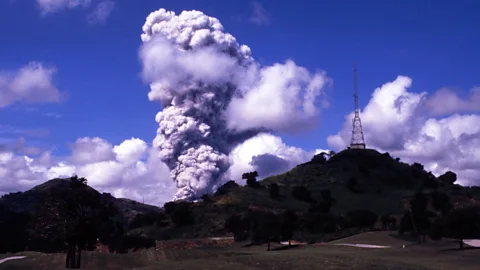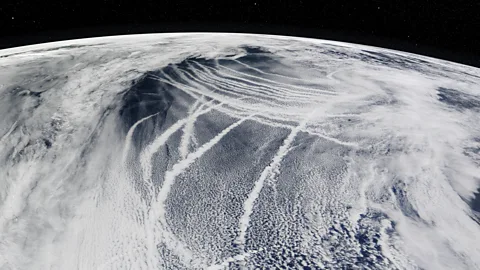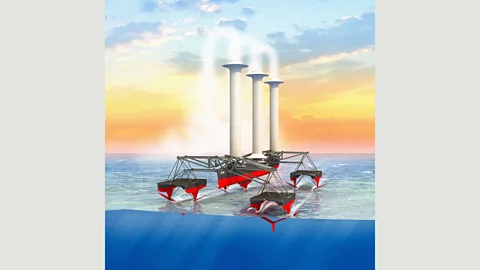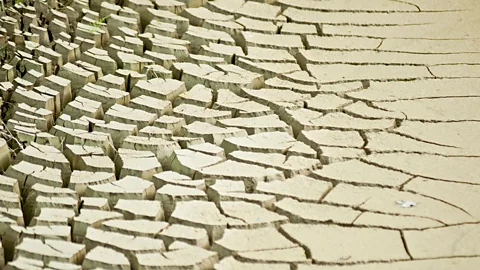How artificially brightened clouds could stop climate change
 Alamy
AlamyThe Earth cools after volcanoes erupt. Now some researchers now think we should mimic those effects to reduce global warming. What could possibly go wrong?
In June, 1991, something surprising happened to the Earth. Mount Pinatubo, in the Philippines, erupted. The first surprise was that it was thought to be a mountain, not a volcano. In fact, pressure built up over centuries beneath this dormant volcano caused the second largest eruption of the 20th Century, spewing vast amounts of white ash and sulphates as high as the stratosphere – 10 km above the Earth’s surface.
Around 15-17 million tonnes of this volcanic material spread into a lazy haze covering much of the globe. During the following 15 months, scientists discovered a second surprise: this particle cloud had formed a protective sun-shield, reflecting a significant proportion of the sun’s rays back into space. As a result, the average global temperature that year dropped by 0.6C. And for some researchers, that raised an interesting possibility. Could we do this on purpose, deliberately producing artificial clouds to reduce global warming?
In truth, we already know the action needed to reduce man-made climate change: a rapid reduction in greenhouse gas emissions, replacing fossil fuels with renewable energy. According to the recent Intergovernmental Panel for Climate Change (IPCC) report, the world has just 12 years in which to cut emissions by half, and 32 years (by 2050) to get net emissions down to zero. However, far from the required dramatic decline, the latest figures show global carbon dioxide emissions actually going up. “Now more than ever, unprecedented and urgent action is required by all nations,” urged the UN’s Emissions Gap Report in November. And some think that artificially engineered reflective clouds may be one important solution.
If you like this, you may also enjoy:
Currently around 30% of the sun’s rays that reach Earth are reflected back to space by white surfaces, largely our polar ice. Sea ice reflects sunlight better than any known natural surface, bouncing around 90% back up; at the other end of the scale, the dark open ocean reflects just 6% of sunlight and absorbs 94%. With Arctic sea ice rapidly declining, replacing one with the other is expected to see global warming accelerate. Unless, that is, we find another white surface that can do the job.
 Alamy
AlamySince Pinatubo, there have been many suggestions for artificial reflective surfaces: launching mirrors into space to orbit around the earth; building wind-powered ice machines over the Arctic, or scattering it with trillions of silica beads. One Peruvian scheme even painted the tops of mountains white to replace retreating glaciers. Clouds, however, naturally reflect the sun (it’s why Venus – a planet with permanent cloud cover – shines so brightly in our night sky). Marine stratocumulus clouds are particularly important, covering around 20% of the Earth’s surface while reflecting 30% of total solar radiation. Stratocumulus clouds also cool the ocean surface directly below. Proposals to make these clouds whiter – or “marine cloud brightening” – are amongst the more serious projects now being considered by various bodies, including the US National Academies of Sciences, Engineering, and Medicine’s new “solar geoengineering” committee.
Stephen Salter, Emeritus professor at the University of Edinburgh, has been one of the leading voices of this movement. In the 1970s, when Salter was working on waves and tidal power, he came across studies examining the pollution trails left by shipping. Much like the aeroplane trails we see criss-crossing the sky, satellite imagery had revealed that shipping left similar tracks in the air above the ocean – and the research revealed that these trails were also brightening existing clouds.
The pollution particles had introduced “condensation nuclei” (otherwise scarce in the clean sea air) for water vapour to congregate around. Because the pollution particles were smaller than the natural particles, they produced smaller water droplets; and the smaller the water droplet, the whiter and more reflective it is. In 1990, British atmospheric scientist John Latham proposed doing this with benign, natural particles such as sea salt. But he needed an engineer to design a spraying system. So he contacted Stephen Salter.
 Nasa Goddard Space Flight Center
Nasa Goddard Space Flight Center“I didn’t realise quite how hard it was going to be,” Salter now admits. Seawater, for instance, tends to clog up or corrode spray nozzles, let alone ones capable of spraying particles just 0.8 micron in size. And that’s not to mention the difficulties of modelling the effects on the weather and climate. But his latest design, he believes, is ready to build: an unmanned hydro-foil ship, computer-controlled and wind-powered, which pumps an ultra-fine mist of sea salt toward the cloud layer.
“Spraying about 10 cubic metres per second could undo all the [global warming] damage we’ve done to the world up until now,” Salter claims. And, he says, the annual cost would be less than the cost to host the annual UN Climate Conference – between $100-$200 million each year.
Salter calculates that a fleet of 300 of his autonomous ships could reduce global temperatures by 1.5C. He also believes that smaller fleets could be deployed to counter-act regional extreme weather events. Hurricane seasons and El Niño, exacerbated by high sea temperatures, could be tamed by targeted cooling via marine cloud brightening. A PhD thesis from the University of Leeds in 2012 stated that cloud brightening could, “decrease sea surface temperatures during peak tropical cyclone season… [reducing] the energy available for convection and may reduce intensity of storms”.
Salter boasts that 160 of his ships could “moderate an El Niño event, and a few hundred [would] stop hurricanes”. The same could be done, he says, to protect large coral reefs such as the Great Barrier Reef, and even cool the polar regions to allow sea ice to return.
Hazard warning
So, what’s the catch? Well, there’s a very big catch indeed. The potential side-effects of solar geoengineering on the scale needed to slow hurricanes or cool global temperatures are not well understood. According to various theories, it could prompt droughts, flooding, and catastrophic crop failures; some even fear that the technology could be weaponised (during the Vietnam War, American forces flew thousands of “cloud seeding” missions to flood enemy troop supply lines). Another major concern is that geoengineering could be used as an excuse to slow down emissions reduction, meaning CO2 levels continue to rise and oceans continue to acidify – which, of course, brings its own serious problems.
 James MacNeill
James MacNeillA rival US academic team – The MCB Project – is less gung-ho than Salter. Kelly Wanser, the principal director of The MCB Project, is based in Silicon Valley. When it launched in 2010 with seed funding from the Gates Foundation, it received a fierce backlash. Media articles talked of “cloud-wrenching cronies” and warned of the potential for “unilateral action on geoengineering”. Since then, Wanser has kept relatively low-key.
Her team’s design is similar to commercial snow-making machines for ski resorts, yet capable of spraying “particles ten thousand times smaller [than snow]… at three trillion particles per second”. The MCB Project hopes to test this near Monterey Bay, California, where marine stratocumulus clouds waft overland. They would start with a single cloud to track its impact.
“One of the strengths of marine cloud brightening is it can be very gradually scaled,” says Wanser. “You [can] get a pretty good grasp of whether and how you are brightening clouds, without doing things that impact climate or weather.”
Such a step-by-step research effort, says Wanser, would take a decade at least. But due to the controversy it attracts, this hasn’t even started yet. Not one cloud has yet been purposefully brightened by academics – although cargo shipping still does this unintentionally, with dirty particles, every single day.
The danger, however, is that solar geoengineering will be eventually called upon as a last chance solution, without the initial research to understand the side effects. “The risks tend to increase the more heat you’re trying to offset,” she says. “The more particles you have to put in, the more likely the side effects are stronger and the risks are greater… this research takes time, and at this point, we can’t even tell you we can build a sprayer that gets these particles to the clouds.”
Fake volcano
There is another approach to solar radiation management that shares the benefits – and the risks – evenly across the globe. Stratospheric aerosol scattering (SAS) is more analogous to Mount Pinatubo: instead of spraying aerosols into the lower atmosphere, you scatter them 10km above the clouds. This suspended, almost static veil of particles – too thin to be visible from the ground – would reflect a proportion of sunlight back into space. Computer modelling by the US National Center for Atmospheric Research in 2017 suggested that for every teragram of particles (one trillion grams – roughly the mass of the Golden Gate Bridge) injected in the atmosphere, a global average temperature reduction of 0.2C could be achieved.
Once again, the consequences are unknown: it’s not clear what impact this strategy would have on the weather systems below, or on the ozone layer directly above it. Unlike a brightened cloud at sea, which may last for three days, an artificial stratospheric layer would likely linger – like the Mount Pinatubo eruption – for up to two years.
 Alamy
AlamyHarvard's Solar Geoengineering Research Program are leading the work on SAS. Elizabeth Burns, its program director, is at pains to tell me, “solar geoengineering could only be a potential complement to emissions reduction. It could not replace those efforts”. This is no “quick fix”, she says. “We really do need to reduce emissions to zero if we want to address climate change.”
If marine cloud brightening has an image problem, then SAS has one that is even worse. Whilst Warner struggles to get a single spray nozzle off the ground, the Harvard academics – led by David Keith – have never propelled a single gram of particles as high as the stratosphere, let alone a teragram. Its current research proposal ‘SCoPEx’ aims to release one kilogram (the weight of a bag of sugar) of calcium carbonate via weather balloon, somewhere high above the continental United States, to analyse the chemical reactions. But even this is highly controversial. When a team in Cambridge, UK, attempted a similar experiment in 2012, it was cancelled at the last minute following criticism from groups including Friends of the Earth.
“One of the biggest taboos around this technology has been this fear, which is a very real fear, that interests vested in fossil fuels and other processes would benefit from the world slowing down the transition to a zero-carbon energy system,” explains Burns. Proponents of this view include Al Gore, who has described solar geoengineering as “insane” and accused the scientists involved of “hubris”.
 Alamy
AlamyThis October, to challenge the US National Academies report, a Manifesto Against Geoengineering was signed by over 100 civil society and indigenous peoples groups, calling for a ban on all geoengineering experiments due to “risks that geoengineering poses to biodiversity, the environment and livelihoods”.
Surprisingly, Burns has a lot of sympathy for that view: “It would be dangerous to deploy solar geoengineering and stop emissions reduction efforts – because if greenhouse gases were to continue to rise, you would need more and more solar geoengineering every year to offset that… basically pushing the Earth’s system even harder, in an experimental way that hasn’t been done before.” Burns likens it to taking morphine to undergo lifesaving surgery; to do solar geoengineering without reducing emissions would be like taking the morphine, but then not undergoing the surgery.
Burns is less sympathetic about the allegation that the research is backed by fossil fuel giants and billionaires. Geoengineering Monitor, the group behind October’s Manifesto, names David Keith and SCoPEx as being backed by “a multimillion geoengineering fund provided by Bill Gates” and highlights ExxonMobil and Shell as “key players”. But Harvard's Solar Geoengineering Research Program “have not and will not accept funding from the fossil fuel industry”, responds Burns. (A full list of funders is published on its website.)
There are many preferable ways to reduce climate change than solar geoengineering. Planting trees – reforesting – is a proven, conservation-friendly method of taking carbon out of the atmosphere. A rapid transition from fossil fuels to renewable energy would tackle the source of emissions. But neither are happening fast enough. Perhaps, if nothing else, even contemplating solar geoengineering may be enough to shock governments into rapid emissions reduction.
If the world says “no” to solar geo-engineering, that “is totally fine with me”, says Burns. “Truthfully this is scary, I hope we don’t have to do it.” But she, and academics such as Salter and Keith, at least want that “no” to be based on scientific evidence.
“We are doing an intervention [already] into our atmosphere in an unprecedented way [through fossil fuel and CO2 emissions],” continues Burns. “We have something that could potentially help with some of the symptoms, albeit not the cure… it is such an important topic globally that we need to start thinking about it.”
--
Tim Smedley is a sustainability writer, based in the UK. His first book, Clearing the Air: The Beginning and the End of Air Pollution, will be published by Bloomsbury in March, 2019.
If you liked this story, sign up for the weekly bbc.com features newsletter, called “If You Only Read 6 Things This Week”. A handpicked selection of stories from BBC Future, Culture, Capital, and Travel, delivered to your inbox every Friday.
